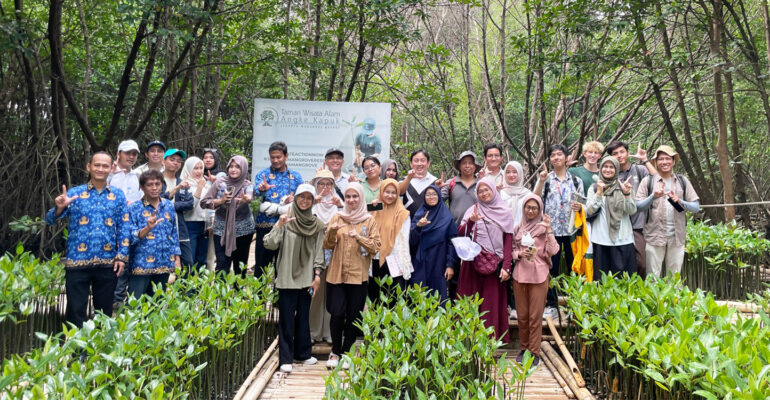IPB University S2 ARL Students Field Trip to Angke Mangrove Landscape

IPB University students from the Master of Landscape Architecture Study Program (S2 ARL) conducted a one-day field trip to the mangrove landscape around Angke Jakarta (28/10). There were three locations visited sequentially, namely the Mangrove Ecotourism Area, Angke Kapuk Nature Tourism Park (TWA), and Muara Angke Wildlife Sanctuary (SMMA).
This visit involved 20 ARL master students, two student assistants, and three lecturers. There are two related courses, namely Sustainable Landscape Management (PLB) and Plants and Green Open Space Systems (TSRTH).
“The purpose of this field trip is for students to experience firsthand the process of mangrove landscape management. Because actually landscape architects will be creatively motivated after traveling and experiencing directly in an authentic spatial space,” explained Dr Kaswanto as the practicum lecturer of PLB course.
Dr Kaswanto continued, “Students are required to be able to develop a management plan of the visited mangrove landscape based on the latest observations.”
Likewise, according to Dr Bambang Sulistyantara as the TSRTH lecturer who explained, “Students really need to know the use of mangrove vegetation in landscape management. Students will be more competent if they know the functions and benefits of mangrove landscapes.”
The first landscape visit was to the Mangrove Ecotourism Area. The group was received by Dimas Ario Nugroho as the Chief of the Forestry Planning Subgroup of the Jakarta Parks and Urban Forests Office (Distamhut).
The welcoming began with a discussion in the welcome area regarding the current state of landscape management. Then continued with direct observation along the interpretation path. It was also filled with direct discussions with officers who were planting or replanting.
“The 200-hectare SMMA landscape has many functions. Of course, apart from being a habitat for animals, saltwater purification, abrasion prevention, preventing seawater intrusion, the mangrove landscape also functions to absorb carbon,” Dimas explained when asked about the function of mangrove landscapes.
“Mangrove landscapes absorb more carbon than other forest types. This is what is being studied related to the calculation of carbon sequestration,” added the alumnus of the ARL Study Program at IPB University.
The group then moved to the second landscape, namely in the Angke Kapuk TWA. They were received in a wooden house for a discussion on 12 principles of sustainable landscape management. The discussion began with a presentation made by Hendra Gunawan as the Conservation Expert Staff of PT Murindra Karya Lestari who is also an alumnus of IPB University.
“We are very pleased to receive a visit from fellow students of IPB University’s Master of Landscape Architecture program. The results of this study will certainly be very in line with the adjustments that will be made by TWA for the upcoming 2027,” Hendra said about his expectations from the visit of IPB University’s ARL Masters students.
Furthermore, the group of students then moved to the last location, namely at SMMA which is located in Kapuk Muara Village, Penjaringan District, North Jakarta. Before dusk, they conducted field observations along the 500-meter interpretation path accompanied by Yusuf Muhammad, Forest Ranger of the Jakarta Natural Resources Conservation Agency (BKSDA).
“We really hope that the visit of IPB University ARL master students can provide study results that can add insight into the management of this SMMA,” hoped Yusuf, who is also an alumnus of IPB University.
“We deliberately chose the object of study on mangrove landscapes because until now there are still rare exposures that raise mangrove objects,” said Maheswara Aulia Khrisna, IPB ARL Masters student who became the chief executive of this activity.
“Moreover, currently the world’s attention to mangrove objects has also increased, so we feel the need to explore the science of structuring and managing mangrove landscapes,” added Maheswara.
Dr Kaswanto elaborated that the results of the study in this field trip will later be presented in the form of an exposition which will be held in the 14th week of this semester. The expose will invite all relevant stakeholders, especially the managers of the three areas visited.
“The goal is that the results of the study can be an input for mangrove landscape managers,” said Dr Kaswanto regarding the follow-up that will be carried out. (*/Rz) (IAAS/RUM)



